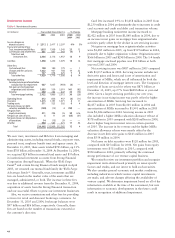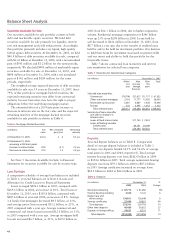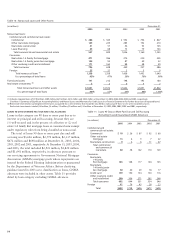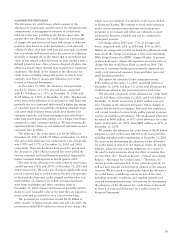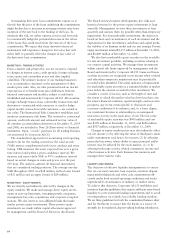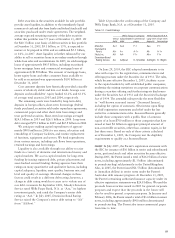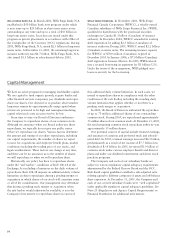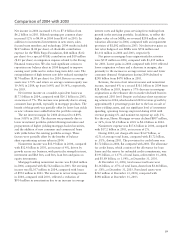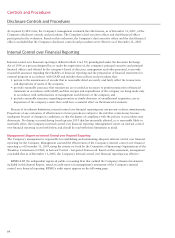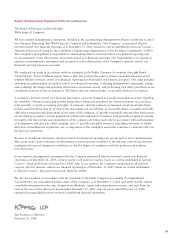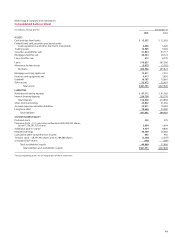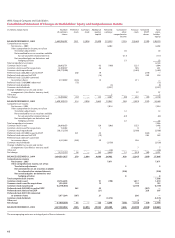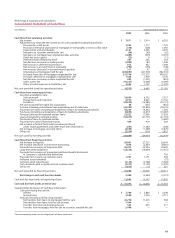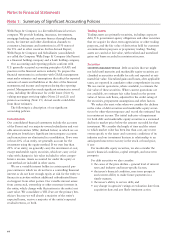Wells Fargo 2005 Annual Report Download - page 56
Download and view the complete annual report
Please find page 56 of the 2005 Wells Fargo annual report below. You can navigate through the pages in the report by either clicking on the pages listed below, or by using the keyword search tool below to find specific information within the annual report.
54
Outstanding derivative loan commitments expose us to
the risk that the price of the loans underlying the commitments
might decline due to increases in mortgage interest rates from
inception of the rate lock to the funding of the loan. To
minimize this risk, we utilize options, futures and forwards
to economically hedge the potential decreases in the values
of the loans that could result from the exercise of the loan
commitments. We expect that these derivative financial
instruments will experience changes in fair value that will
either fully or partially offset the changes in fair value of
the derivative loan commitments.
MARKET RISK – TRADING ACTIVITIES
From a market risk perspective, our net income is exposed
to changes in interest rates, credit spreads, foreign exchange
rates, equity and commodity prices and their implied
volatilities. The primary purpose of our trading businesses
is to accommodate customers in the management of their
market price risks. Also, we take positions based on market
expectations or to benefit from price differences between
financial instruments and markets, subject to risk limits
established and monitored by Corporate ALCO. All securities,
foreign exchange transactions, commodity transactions and
derivatives—transacted with customers or used to hedge
capital market transactions with customers—are carried at
fair value. The Institutional Risk Committee establishes and
monitors counterparty risk limits. The notional or contractual
amount, credit risk amount and estimated net fair value of
all customer accommodation derivatives at December 31, 2005
and 2004, are included in Note 26 (Derivatives) to Financial
Statements. Open, “at risk” positions for all trading business
are monitored by Corporate ALCO.
The standardized approach for monitoring and reporting
market risk for the trading activities is the value-at-risk
(VAR) metrics complemented with factor analysis and stress
testing. VAR measures the worst expected loss over a given
time interval and within a given confidence interval. We
measure and report daily VAR at 99% confidence interval
based on actual changes in rates and prices over the past
250 days. The analysis captures all financial instruments
that are considered trading positions. The average one-day
VAR throughout 2005 was $18 million, with a lower bound
of $11 million and an upper bound of $24 million.
MARKET RISK – EQUITY MARKETS
We are directly and indirectly affected by changes in the
equity markets. We make and manage direct equity invest-
ments in start-up businesses, emerging growth companies,
management buy-outs, acquisitions and corporate recapital-
izations. We also invest in non-affiliated funds that make
similar private equity investments. These private equity
investments are made within capital allocations approved
by management and the Board of Directors (the Board).
The Board reviews business developments, key risks and
historical returns for the private equity investments at least
annually. Management reviews these investments at least
quarterly and assesses them for possible other-than-temporary
impairment. For nonmarketable investments, the analysis is
based on facts and circumstances of each investment and the
expectations for that investment’s cash flows and capital needs,
the viability of its business model and our exit strategy. Private
equity investments totaled $1,537 million at December 31, 2005,
and $1,449 million at December 31, 2004.
We also have marketable equity securities in the available
for sale investment portfolio, including securities relating to
our venture capital activities. We manage these investments
within capital risk limits approved by management and the
Board and monitored by Corporate ALCO. Gains and losses
on these securities are recognized in net income when realized
and other-than-temporary impairment may be periodically
recorded when identified. The initial indicator of impairment
for marketable equity securities is a sustained decline in market
price below the amount recorded for that investment. We
consider a variety of factors, such as the length of time and
the extent to which the market value has been less than cost;
the issuer’s financial condition, capital strength, and near-term
prospects; any recent events specific to that issuer and
economic conditions of its industry; and, to a lesser degree,
our investment horizon in relationship to an anticipated
near-term recovery in the stock price, if any. The fair value
of marketable equity securities was $900 million and cost
was $558 million at December 31, 2005, and $696 million
and $507 million, respectively, at December 31, 2004.
Changes in equity market prices may also indirectly affect
our net income (1) by affecting the value of third party assets
under management and, hence, fee income, (2) by affecting
particular borrowers, whose ability to repay principal and/or
interest may be affected by the stock market, or (3) by
affecting brokerage activity, related commission income and
other business activities. Each business line monitors and
manages these indirect risks.
LIQUIDITY AND FUNDING
The objective of effective liquidity management is to ensure
that we can meet customer loan requests, customer deposit
maturities/withdrawals and other cash commitments effi-
ciently under both normal operating conditions and under
unpredictable circumstances of industry or market stress.
To achieve this objective, Corporate ALCO establishes and
monitors liquidity guidelines that require sufficient asset-based
liquidity to cover potential funding requirements and to avoid
over-dependence on volatile, less reliable funding markets.
We set these guidelines for both the consolidated balance sheet
and for the Parent to ensure that the Parent is a source of
strength for its regulated, deposit-taking banking subsidiaries.


